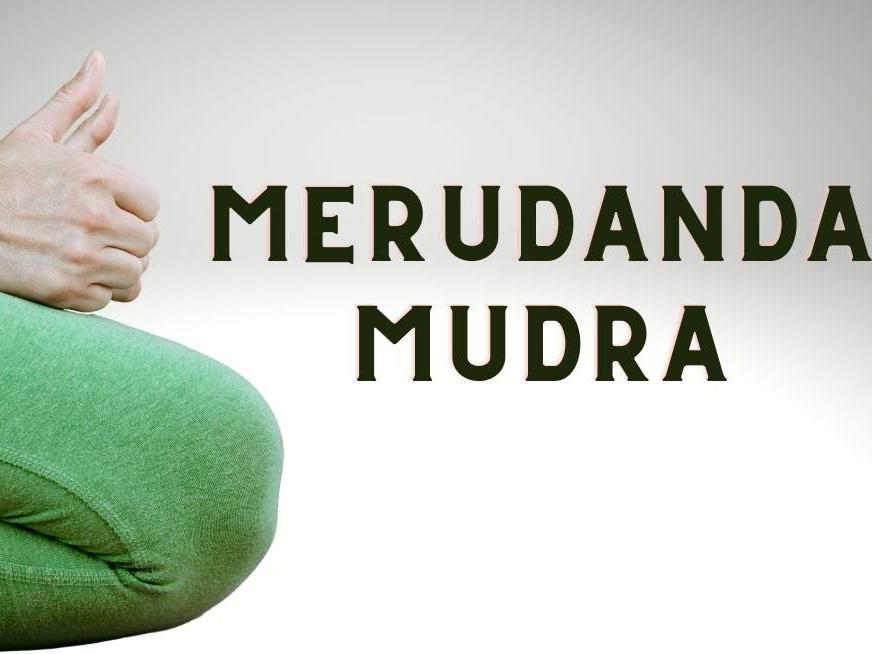Merudanda Mudra is the topic of discussion today. It is a distinct yoga mudra that is performed in combination with pranayama. In the realm of Ayurveda, yoga mudras are considered a healing modality. The term “mudra” is derived from Sanskrit and can be translated as a sign or attitude. A mudra can involve the entire body or simply be a hand position. When combined with the flow of prana through the practice of yoga, mudras stimulate various parts of the body and enhance the breath. In this article, we will delve into the meaning of merudanda mudra, explain the steps to perform it, and explore its benefits. Accompanying images will also be provided for better understanding.

Merudanda Mudra Meaning:
The Merudanda technique is commonly used for Pranayama, but it can also be employed for our ‘Pranic Breathing’ techniques and Meditation. When practiced during meditation, Merudanda has a profound centering and calming effect. To enhance its benefits, it can be combined with the ‘inner-smile’ method and Shambhavi mudra, which involves focusing attention on a specific point in the body.
Merudanda Mudra is a hand gesture that brings attention to the breath. It allows you to feel the breath flowing throughout your body. This mudra can be practiced in a seated or standing position. To perform Merudanda mudra, keep your thumb straight and touch all four fingers to your palm. Place your palms above your knees and begin breathing slowly and with control.
The position of your thumb determines where the energy flows. If your thumb is turned inward, the energy moves towards the lungs and lower abdomen. If you keep your thumb facing upward, the energy travels towards the mid-section of your body. By turning your thumbs outwards, you can energize your chest and spine.
Repeat each breathing step 8 to 10 times to maximize the benefits of this mudra. Practicing Merudanda Mudra can help you bring awareness to your breath and experience its effects throughout your entire body.
Merudanda Mudra Steps:
- Sit down with your spine straight and tall.
- Relax your hands on your thighs.
- Twist your hands into fists, palms facing downward, with thumbs extending towards each other.
- Hold this position deliberately for five minutes.
- Focus on breathing slowly and taking deep breaths
Merudanda Mudra 2:
In Pranayama, the pause between the in-breath and out-breath, or vice versa, is considered crucial. This pause is known as ‘Kumbhaka’ and it provides a momentary opportunity for yogis to experience a glimpse of what lies beyond the incessant activity of our minds. It’s similar to looking through a window into an unfamiliar external world, which is deeply connected to our internal space.
The positioning of the thumbs plays a significant role in the practice of Merudanda. When the thumbs face inwards, it channels energy to the lower region of the body, including the lungs and the lower abdominal area. On the other hand, if the thumbs are positioned upwards, it directs Prana (life force) to the mid-section of the body. Lastly, when the thumbs are curved outwards, it helps channel Prana to the upper chest and spine. These different hand positions serve to distribute and balance the flow of Prana throughout the body.
Merudanda Mudra 3:
In Pranayama, the pause between the in-breath and out-breath is crucial. Yogis use Mudras in each cycle of the twist, so try different positions to see which works best for you. Sometimes people struggle with either the in-breath or the out-breath. Breathing difficulties may be felt in the lower areas of the chest, such as the lower abdominals. The idea is that individuals who habitually breathe shallowly could benefit from using Merudanda 3.
Benefits Of Merudanda Mudra:
- This yoga asana has multiple benefits for the spine, Ida, Pingla, and Sushumna Nadis.
- It can effectively reduce a bulging stomach, obesity, and distended spleen and liver.
- The asana activates the flow of Prana in the Brahma Nadi, Sushumna, and initiates Kundalini awakening.
- Incorporation of hand gestures in the Sacred Spiral enhances breath-work and adds beauty.
- It stimulates the gastric fire and improves the functioning of abdominal organs, liver, kidneys, and helps with various issues such as dyspepsia, gastritis, piles, prostate problems, nerves bladder conditions, and even diabetes.
- Practicing this asana helps circulate Prana along the spine, rejuvenating the back and alleviating back pain.
If you want to learn about Merudanda Mudra, you can find all the details here. This resource provides comprehensive information on the technique, including helpful tips and precautions. By following the guidelines provided, you will be able to practice the mudra more easily and effectively.
